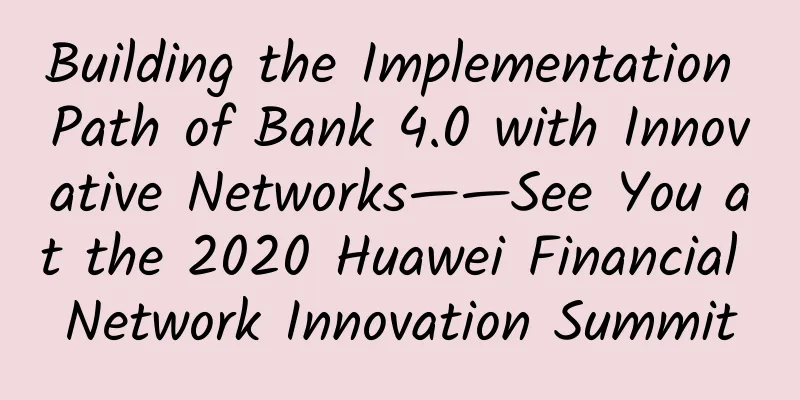Building the Implementation Path of Bank 4.0 with Innovative Networks——See You at the 2020 Huawei Financial Network Innovation Summit

|
To preserve and increase the value of wealth is a question that everyone is concerned about. To achieve this goal, even in the current era of extremely advanced communication methods, most ordinary people still need to obtain professional guidance and advice through joining groups, taking classes, and consulting at outlets. When daily life and work have already made many people "try their best", the threshold for such customers is still too high. Therefore, many times we can't help but imagine such a scene: In their spare time, the AI-based investment and financial management assistant will automatically recommend and configure financial products for users based on their investment preferences, and put all the choices and combinations in front of users; and when users take time out, they can seamlessly carry out the subsequent processing procedures at any time through unmanned and automated offline outlets. Or, all of this can be done through mobile phones and cloud technology. So, how can such financial services come about? For financial companies, realizing the ideal scenario also requires overcoming many constraints. In the past financial work, "soundness" often means more and stricter audits and risk control, while "flexibility" and "proactivity" are usually the opposite. But when soundness, flexibility and positivity appear in the work requirements at the same time, how should financial companies respond? New infrastructure provides new opportunities for financial development New infrastructure is undoubtedly the hottest keyword this year, for no other reason than that the new infrastructures such as 5G, AI, Internet of Things, and big data included in it are providing a development path for thousands of industries other than steel and concrete. For the financial industry, these are the most important technical supports in the process of building Bank 4.0. As a continuation of the Bank 3.0 concept, Bank 4.0 further strengthens the concept and depth of services. Although its focus is still not on Fintech itself, its new financial service system construction ideas based on technological evolution have pointed out the development direction for the financial industry, which is already in the deep waters of transformation. In the Bank 4.0 concept, Brett King pointed out directly: Banking Everywhere, Never at a Bank. Obviously, in the eyes of this godfather of banking innovation, financial services will be everywhere. First, to make a type of service ubiquitous, it is obviously far from enough to rely solely on large-scale "people pulling and shouldering" promotion. Financial companies need a high-bandwidth wireless network to present a variety of media-rich services to different users. Secondly, ubiquitous financial services must be personalized and integrated, so a real-time and flexible financial network that can match the ever-changing business is also indispensable. Of course, in any era and any changes, the financial demand for network security standards remains unchanged. So, how should the financial network in the Bank 4.0 era be constructed? New technologies empower new finance At the business level, with the development of the industry, today's financial enterprises have more and more innovative ideas and practices. Even in terms of delivery methods, financial enterprises have developed a variety of forms such as smart terminals, Web services, and mobile apps. How to use the network to connect business, terminals, and users with financial enterprises is an important issue that financial enterprises must solve in the process of Bank 4.0 or the deep waters of financial digital transformation. To solve network problems, the evolution of network technology will be the best answer. 01. 5G, SD-WAN+WiFi 6: Wireless connection, unlimited possibilities At the WAN level, the new generation of wireless communication technology represented by 5G provides users with higher bandwidth, which allows rich media and complex applications to be presented to users at a faster speed. For financial companies, the slicing function of 5G networks makes this new communication standard an ideal channel for carrying key financial services after traditional dedicated lines. By using WAN management technologies represented by SD-WAN, financial companies can make 5G dedicated lines and traditional dedicated lines work together in the same system, simplifying management while achieving "one-hop to the cloud" for terminal services. On one hand, there is a better user experience, and on the other hand, there is a brand new business delivery pipeline. The importance of the combination of 5G and SD-WAN to finance is self-evident. Under the wide area network, the emergence and popularity of the WiFi 6 standard are similar. By deploying high-bandwidth, low-latency, multi-device, and highly reliable WiFi 6 networks in financial scenarios, financial enterprises can not only achieve high-speed device connections with lower costs and fewer devices, but also use a unified and flexible business-based strategy to build a network from the cloud core room to the first-level outlets, to the second-level outlets, and then to the terminal, bringing the operation and management of business-based networks to a new dimension. 02. SRv6: More devices, simpler protocol Since intelligence is one of the core evolutionary directions of finance, there will inevitably be more and more devices involved in the future financial business chain. More devices, more businesses, and greater traffic will obviously bring greater pressure to the internal network of financial enterprises. SRv6 is the best choice to solve this problem. SRv6 (Segment Routing IPv6) first provides full support for IPv6, which will bring a higher capacity limit to the entire financial ICT system and solve many practical problems in the networking process. The Segment Routing function, which is at the core of SRv6, can achieve traffic orchestration by adding Segment IDs to packets. Compared with the complex combination of MPLS and TE Tunnel in the traditional solution, traffic orchestration implemented through SRv6 can reduce the actual pressure on switches at all levels on the one hand, and on the other hand, it can achieve full matching of SLA levels, behavior processing, path planning and other actions with services through a single protocol, thereby further reducing network complexity and management difficulty. At the same time, as an open standard, SRv6 can also avoid financial companies being deeply bound by private technologies while being compatible with more businesses. 03. Financial networks should be “driverless” For any system, management is a double-edged sword. If it is well managed, efficiency and cost are not a problem; if it is not well managed, it will become a black hole of cost and reliability. In the future, with the high complexity of financial services, the diversity of business scenarios, the multi-dimensional development of network media and the complexity of links, the management of financial networks will inevitably become extremely difficult. It will be unrealistic to manage such a network with manpower in terms of cost and efficiency. Through the combined application of AI, visualization, probes and other technologies, the new generation of networks should be automated and intelligent. Through a large screen that combines overall planning and details, network managers can complete real-time traffic monitoring, rapid fault location and root cause analysis, and real-time risk notifications in the control room... Through this combination of functions, the network of financial enterprises can be intelligent, agile and secure, and have an "all-knowing and all-powerful" perspective on network management. 04. Multi-dimensional security is a must As the guarantee of people's livelihood and the blood of economic operation, financial security is an issue that Bank 4.0 and any Fintech cannot avoid. For typical high-value ICT systems such as finance, financial enterprises must not only pay attention to the reliability of traditional services, but also ensure that the entire system is protected from various attacks as more and more devices and applications participate. The difficulty is imaginable. Since the network is the source of various security risks and threats, it must also be capable of resisting risks and threats during management and design. At a higher technological strategic dimension, faced with the high uncertainty of the international political and economic environment, financial companies should also take the security, controllability and continuous evolution capabilities of the technology stack into consideration when developing business and deploying systems. 2020 Huawei Financial Network Innovation Summit: A glimpse into the intelligent network of the Bank 4.0 era
Brett King’s description of Bank 4.0 is very “non-technical”; however, technology is indispensable to realize the Bank 4.0 vision. Network technology is not all of Fintech, but it is an important link that turns various innovations into Bank 4.0 reality. In the field of networks, Huawei's strength is self-evident; and in the financial network segment, Huawei, standing on a high ground, has even greater strength than its peers. At the 5G+SD-WAN level, Huawei's AirEngine AR6000 series is not only the world's first commercial 5G routing product, but its built-in SD-WAN-based management function also enables financial companies to use 5G and make good use of 5G in different scenarios. In the field of Wi-Fi 6, Huawei has a massive product portfolio and patented smart antenna technology, which can provide a new connection experience while achieving wider coverage and higher speed. At the management level, the ADN (Autonomous Driving Network) network solution composed of iMaster NCE and MAE brings the operation and management of financial networks into the era of simple networking and intelligent management. More importantly, Huawei is now able to provide financial enterprises with end-to-end security and controllability. From 2018 to the first half of 2020, Huawei's share in the financial data communication market has continued to grow. Such achievements are not only due to Huawei's unremitting pursuit at the product level, but also due to Huawei and its massive partners' understanding and insight into future financial trends and scenarios under the guidance of the "knowledgeable" strategy. August 12-14, 2020, Yunnan; At this time when the half-closed door of the digital age has been opened, let us take advantage of the power of the Internet, jointly foresee the mutual achievements of network technology and Bank 4.0, and listen to the experiences of industry pioneers. +Smart Networks Travel the World, See you at the 2020 Huawei Financial Network Innovation Summit. |
>>: TCP/IP knowledge point: host-to-host layer protocol
Recommend
Super detailed explanation of Socket communication principles and examples
We are well aware of the value of information exc...
Application of Passive WDM Technology in 5G Fronthaul
Labs Guide Passive WDM technology is the main tec...
Talk about the other side of 5G that you don’t know
At present, domestic policies mainly revolve arou...
Evoxt's new Japanese VPS starts at $2.99 per month, 512MB/5GB/250GB@1Gbps/Softbank line
I shared Evoxt once in June this year. It is a fo...
With the handshake of 5G, intelligent transportation will usher in four major qualitative changes!
At present, for any ToB market, 5G+AI is creating...
The power behind the success of Wuhan East Lake Comprehensive Bonded Zone Smart Park project
[51CTO.com original article] With the rapid devel...
spinservers: 10Gbps bandwidth high-end server starting at $89 per month, Dallas/San Jose data center
spinservers is a business that mainly provides ov...
What does the expansion of 4G mean for big data?
As the market share of smartphones continues to g...
How can operators play the 5G messaging card well?
5G is a technology that can rewrite the "rul...
Currently, CDN security is far from enough
Today, many businesses realize that DDoS defense ...
5G issues should not be politicized
The official website of the European Competitive ...
DHCP in 37 pictures: The invisible person who gives you your IP address
DHCP appears A computer or mobile phone needs an ...
Six advantages of deploying SD-WAN
With the increase in data analysis, media traffic...
Essential for operation and maintenance: 20 common service ports and their corresponding service information
In the operation and maintenance process, it is c...
China Telecom: Continue to build a comprehensive 5G private network solution integrating "network edge cloud and service"
With the continuous advancement of "new infr...









